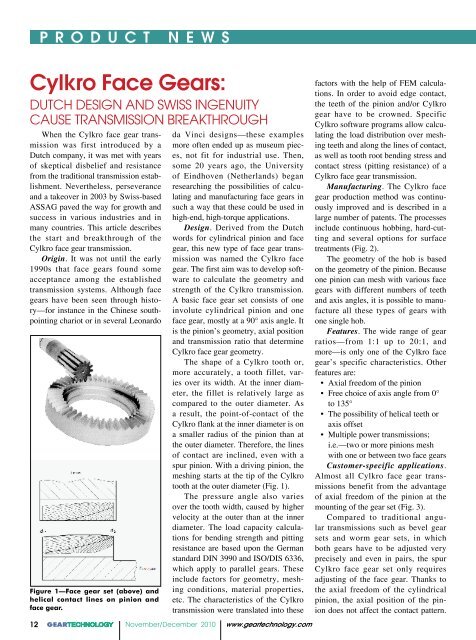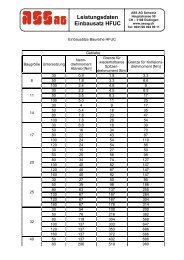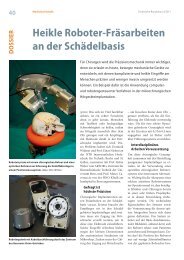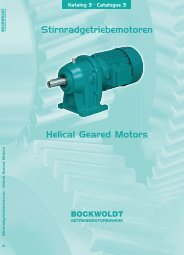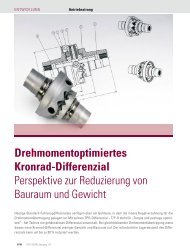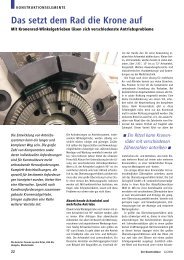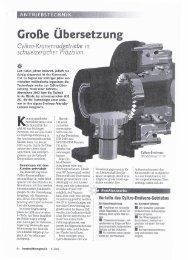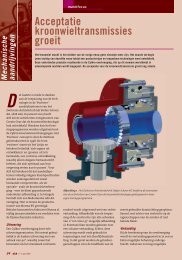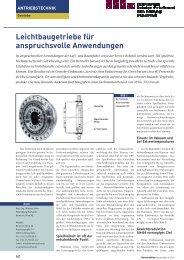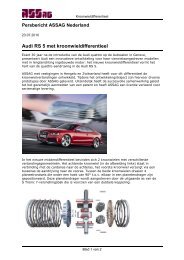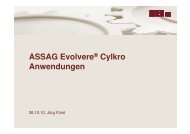Cylkro Face Gears.pdf
Cylkro Face Gears.pdf
Cylkro Face Gears.pdf
You also want an ePaper? Increase the reach of your titles
YUMPU automatically turns print PDFs into web optimized ePapers that Google loves.
12<br />
P R O D U C T N E W S<br />
<strong>Cylkro</strong> <strong>Face</strong> <strong>Gears</strong>:<br />
DUTCH DESIGN AND SWISS INGENUITY<br />
CAUSE TRANSMISSION BREAKTHROUGH<br />
When the <strong>Cylkro</strong> face gear transmission<br />
was first introduced by a<br />
Dutch company, it was met with years<br />
of skeptical disbelief and resistance<br />
from the traditional transmission establishment.<br />
Nevertheless, perseverance<br />
and a takeover in 2003 by Swiss-based<br />
ASSAG paved the way for growth and<br />
success in various industries and in<br />
many countries. This article describes<br />
the start and breakthrough of the<br />
<strong>Cylkro</strong> face gear transmission.<br />
Origin. It was not until the early<br />
1990s that face gears found some<br />
acceptance among the established<br />
transmission systems. Although face<br />
gears have been seen through history—for<br />
instance in the Chinese southpointing<br />
chariot or in several Leonardo<br />
Figure 1—<strong>Face</strong> gear set (above) and<br />
helical contact lines on pinion and<br />
face gear.<br />
da Vinci designs—these examples<br />
more often ended up as museum pieces,<br />
not fit for industrial use. Then,<br />
some 20 years ago, the University<br />
of Eindhoven (Netherlands) began<br />
researching the possibilities of calculating<br />
and manufacturing face gears in<br />
such a way that these could be used in<br />
high-end, high-torque applications.<br />
Design. Derived from the Dutch<br />
words for cylindrical pinion and face<br />
gear, this new type of face gear transmission<br />
was named the <strong>Cylkro</strong> face<br />
gear. The first aim was to develop software<br />
to calculate the geometry and<br />
strength of the <strong>Cylkro</strong> transmission.<br />
A basic face gear set consists of one<br />
involute cylindrical pinion and one<br />
face gear, mostly at a 90° axis angle. It<br />
is the pinion’s geometry, axial position<br />
and transmission ratio that determine<br />
<strong>Cylkro</strong> face gear geometry.<br />
The shape of a <strong>Cylkro</strong> tooth or,<br />
more accurately, a tooth fillet, varies<br />
over its width. At the inner diameter,<br />
the fillet is relatively large as<br />
compared to the outer diameter. As<br />
a result, the point-of-contact of the<br />
<strong>Cylkro</strong> flank at the inner diameter is on<br />
a smaller radius of the pinion than at<br />
the outer diameter. Therefore, the lines<br />
of contact are inclined, even with a<br />
spur pinion. With a driving pinion, the<br />
meshing starts at the tip of the <strong>Cylkro</strong><br />
tooth at the outer diameter (Fig. 1).<br />
The pressure angle also varies<br />
over the tooth width, caused by higher<br />
velocity at the outer than at the inner<br />
diameter. The load capacity calculations<br />
for bending strength and pitting<br />
resistance are based upon the German<br />
standard DIN 3990 and ISO/DIS 6336,<br />
which apply to parallel gears. These<br />
include factors for geometry, meshing<br />
conditions, material properties,<br />
etc. The characteristics of the <strong>Cylkro</strong><br />
transmission were translated into these<br />
GEARTECHNOLOGY November/December 2010 www.geartechnology.com<br />
factors with the help of FEM calculations.<br />
In order to avoid edge contact,<br />
the teeth of the pinion and/or <strong>Cylkro</strong><br />
gear have to be crowned. Specific<br />
<strong>Cylkro</strong> software programs allow calculating<br />
the load distribution over meshing<br />
teeth and along the lines of contact,<br />
as well as tooth root bending stress and<br />
contact stress (pitting resistance) of a<br />
<strong>Cylkro</strong> face gear transmission.<br />
Manufacturing. The <strong>Cylkro</strong> face<br />
gear production method was continuously<br />
improved and is described in a<br />
large number of patents. The processes<br />
include continuous hobbing, hard-cutting<br />
and several options for surface<br />
treatments (Fig. 2).<br />
The geometry of the hob is based<br />
on the geometry of the pinion. Because<br />
one pinion can mesh with various face<br />
gears with different numbers of teeth<br />
and axis angles, it is possible to manufacture<br />
all these types of gears with<br />
one single hob.<br />
Features. The wide range of gear<br />
ratios—from 1:1 up to 20:1, and<br />
more—is only one of the <strong>Cylkro</strong> face<br />
gear’s specific characteristics. Other<br />
features are:<br />
• Axial freedom of the pinion<br />
• Free choice of axis angle from 0°<br />
to 135°<br />
• The possibility of helical teeth or<br />
axis offset<br />
• Multiple power transmissions;<br />
i.e.—two or more pinions mesh<br />
with one or between two face gears<br />
Customer-specific applications.<br />
Almost all <strong>Cylkro</strong> face gear transmissions<br />
benefit from the advantage<br />
of axial freedom of the pinion at the<br />
mounting of the gear set (Fig. 3).<br />
Compared to traditional angular<br />
transmissions such as bevel gear<br />
sets and worm gear sets, in which<br />
both gears have to be adjusted very<br />
precisely and even in pairs, the spur<br />
<strong>Cylkro</strong> face gear set only requires<br />
adjusting of the face gear. Thanks to<br />
the axial freedom of the cylindrical<br />
pinion, the axial position of the pinion<br />
does not affect the contact pattern.
Pinions can be exchanged easily and<br />
do not require meshing in pairs with<br />
the <strong>Cylkro</strong> face gear. This is of great<br />
benefit when there is expansion in the<br />
pinion axis due to heat generation. Or,<br />
the feature can also be utilized when<br />
the axial freedom becomes part of the<br />
application’s function. For example,<br />
Saueressig embossing machines use<br />
the feature to slide one embossing<br />
cylinder closer to the second embossing<br />
cylinder. Another example is the<br />
starter gear in the Porsche Carrera GT,<br />
of which only an exclusive 1,200 cars<br />
were built and in which the pinion is<br />
axially pushed into the face gear at the<br />
moment of starting the engine.<br />
It is possible to choose any axis<br />
angle between 0° and 135°, of which<br />
90° is the most common. Smaller axis<br />
angles, such as 17°, are used in mixing<br />
equipment or driven tools with<br />
45° angles from Sauter Feinmechanik<br />
GmbH (Fig. 4) and Benz-driven tools<br />
for the metal working industry.<br />
<strong>Face</strong> gear sets with a helix angle<br />
are used, for instance, in automatic<br />
door systems. In this example (Fig. 5),<br />
the pinion only has three teeth and is<br />
shaped almost like a worm. However,<br />
the helical <strong>Cylkro</strong> transmission’s efficiency<br />
remains very high as compared<br />
to the loss of efficiency in worm gear<br />
sets. Another advantage, specifically<br />
for the door system application, is the<br />
lack of self-braking factor. This means<br />
that in case of power failure and emergency,<br />
the doors can be opened easily<br />
by hand.<br />
Gear ratios in the range of 1:1 to<br />
1:5 are the typical choice for power<br />
applications. Larger gear ratios<br />
are more often used in hand-driven<br />
applications or in precision solutions<br />
such as printing machines or optical<br />
machinery from Zeiss. U.S.-based<br />
Danaher Motion has a full range of<br />
angle gear heads in which a total of<br />
29 different <strong>Cylkro</strong> face gear sets are<br />
used. The gear head range is divided<br />
into five sizes, each size covering a<br />
gear ratio range of 1:1 to 1:5.<br />
Finally, the multiple-power transmission—in<br />
which one or more pinions<br />
mesh with one wheel or between<br />
two <strong>Cylkro</strong> face gears—has been real-<br />
Figure 2—Manufacturing of <strong>Cylkro</strong> face<br />
gears by a six-axis CNC spur gear hobbing<br />
machine.<br />
Figure 3—Axial freedom of the pinion<br />
in face gear transmissions.<br />
Figure 4—Compact tool exchanger<br />
based on face gear transmission.<br />
P R O D U C T N E W S<br />
ized, for instance, in Hydrosta BV<br />
bow thrusters (Fig. 6) and Index Traub<br />
turning machines (Fig. 7).<br />
continued<br />
Figure 5—Automatic door moving system<br />
with <strong>Cylkro</strong> transmission.<br />
Figure 6—<strong>Cylkro</strong> face gears in counterrotating<br />
bow thrusters achieve higher<br />
efficiency.<br />
Figure 7—Multimodal Index Traub<br />
turning machine with inner and outer<br />
face gear rings.<br />
www.geartechnology.com November/December 2010 GEARTECHNOLOGY 13
14<br />
P R O D U C T N E W S<br />
Center Differential of the New<br />
Audi Quattro with <strong>Cylkro</strong> <strong>Face</strong><br />
Gear Technology<br />
An enormous breakthrough for<br />
the multiple-power <strong>Cylkro</strong> face gear<br />
transmission in the field of automotive<br />
applications was the introduction at the<br />
Geneva Autosalon earlier this year of<br />
the new Audi Quattro RS 5 with a selflocking<br />
crown gear differential in the<br />
Quattro drive train, which regulates the<br />
power distribution between the front<br />
and rear axles.<br />
Two <strong>Cylkro</strong> face gears with different<br />
tooth geometries, resulting in<br />
a 40:60% torque split, are built into<br />
this lightweight differential (4.8 kg).<br />
ASSAG was given the responsibility<br />
of developing the tooth geometry of<br />
the face gears and pinions that are used<br />
in the heart of the Quattro drivetrain.<br />
Finally the successful cooperation<br />
resulted in a common patent applica-<br />
Figure 8—Detail of the Audi Quattro RS 5 center differential.<br />
Figure 9—Embedded face gear center differential.<br />
tion and ASSAG granted a license for<br />
serial production of the <strong>Cylkro</strong> face<br />
gears. Using the <strong>Cylkro</strong> face gear technology,<br />
Audi could realize a weight<br />
reduction of 2 kg compared to the conventional<br />
differential. Furthermore, the<br />
package of plates of the differential<br />
could be considerably reduced.<br />
How it works. The <strong>Cylkro</strong> face<br />
gear with the largest number of teeth<br />
(Fig. 8, left side) is connected with the<br />
cardan shaft to the rear axle. The second<br />
face gear takes care of the power<br />
take-off to the front axle. In between<br />
the face gears, four planetary pinions<br />
are equally spaced at 90° in a planet<br />
carrier that is driven by the outgoing<br />
axis of the S-tronic 7-speed gearbox<br />
with double clutch.<br />
The self-locking crown gear center<br />
differential attains a high efficiency<br />
ratio. This standard rear-biased configuration<br />
ensures sporty handling of<br />
GEARTECHNOLOGY November/December 2010 www.geartechnology.com<br />
the vehicle. In the basic situation, there<br />
is no difference in rotational speeds of<br />
the face gears and the planet carrier.<br />
If one of the axles starts to spin, for<br />
example, while it is on ice or snow,<br />
the self-locking face gear center differential<br />
will immediately engage. By<br />
a package of plates, the differential<br />
can widely vary the torque distribution<br />
between the front and rear axles. Up<br />
to 70% of the drive force can be fed to<br />
the front, and as much as 85% toward<br />
the tail-end (Fig. 9).<br />
ASSAG could realize this wide<br />
variation by exactly locating and tolerating<br />
the contact patterns between<br />
the pinions and face gears. These contact<br />
patterns have been pre-defined by<br />
ASSAG within specified limitations.<br />
This leads to certain axial forces on<br />
the face gears and on the package of<br />
plates, finally resulting in a variation<br />
of the torque distribution in such a<br />
way that ASSAG could fulfill all Audi<br />
specifications.<br />
In the crown gear differential,<br />
the gears are mounted without backlash.<br />
The result is a homogeneous<br />
conversion of the torque distribution<br />
without any delay. In conjunction<br />
with intelligent software in the<br />
braking system, the Quattro system<br />
assigns optimal torque to every driven<br />
wheel. Interventions of the ESP system<br />
will be reduced to a minimum. This<br />
increases the drivability of the Audi<br />
RS 5 in every situation. (After the<br />
release of the RS 5, Audi will equip<br />
future Quattro series with the face gear<br />
differential.)<br />
Catalog products. The earlier mentioned<br />
Danaher’s gear range was the<br />
instigator for ASSAG to look at its<br />
own standard range of catalog <strong>Cylkro</strong><br />
face gear sets. This way, <strong>Cylkro</strong> face<br />
gear sets would also become available<br />
as a standard program allowing short<br />
delivery times and competitive prices.<br />
The program covers torques from 0.7<br />
to 518 Nm at ratios up to 1:10. More<br />
information on the standard program<br />
is available in the <strong>Cylkro</strong> catalog or
online on the ASSAG homepage.<br />
Evolvere solutions. With the takeover<br />
by ASSAG Switzerland, new<br />
engineering knowledge and experience<br />
became available for the <strong>Cylkro</strong> technology.<br />
It found its way to the market<br />
not only as a face gear set, but, thanks<br />
to ASSAG’s “Evolvere” concept, it is<br />
now also available as a complete angular<br />
gearbox. Evolvere is Latin for “to<br />
evolve” and so the Evolvere trademark<br />
stands for the optimal added value<br />
of Swiss transmission technology. It<br />
includes support in evaluating the best<br />
solution, considering cost-effective<br />
components and easy mounting and<br />
maintenance. ASSAG engineers construct<br />
transmissions of all types, for<br />
all kinds of industries and design animated<br />
3-D models.<br />
ASSAG provides three types of<br />
standard Evolvere gearboxes:<br />
• Block-shaped gearboxes for<br />
90° transmission ratios 1:1 to<br />
1:4 (Fig. 10)<br />
• Compact, flat gearbox for 90°<br />
transmissions with ratios 1:5 to<br />
1:10 (Fig. 11)<br />
• Octagonal gearboxes<br />
(Octodrive) for different angles<br />
and multiple inputs/outputs with<br />
ratios 1:3 and higher (Fig. 12).<br />
All of them use the standard<br />
<strong>Cylkro</strong> face gear sets from the <strong>Cylkro</strong><br />
catalog as described earlier.<br />
Octodrive Transmission Offers<br />
Customer-Driven Choices<br />
ASSAG’s angular gearbox program—Octodrive—affords<br />
customers<br />
the freedom of choosing the number of<br />
inputs, outputs, angles, ratios and other<br />
options. The customer has the possibility<br />
to design the gearbox according<br />
to his needs by choosing the relevant<br />
components in a dialog window. This<br />
allows for generation of multifunctional<br />
and high-quality angular gears<br />
quickly, with the resulting octagonal<br />
gearbox available from ASSAG partners<br />
or via the internet.<br />
Octodrive face gear drives are<br />
continued<br />
P R O D U C T N E W S<br />
P R O D U C T N E W S<br />
Figure 10—Block-shaped 1:1 and flat 1:5 versions of the Evolvere angular gearbox<br />
family.<br />
Figure 11—Octodrive gearbox (sectional view) in different configurations.<br />
Figure 12—Up to eight pinion shafts on one layer can be mounted (left).<br />
Depending on the application, only one output may be needed. If required, it can<br />
be combined with a second face gear.<br />
Figure 13—Application examples of Octodrive face gear transmissions: tableadjustment<br />
and multiple-lift drive combination.<br />
Figure 14—As a tool for researchers and educational purposes, Octodrive allows<br />
for the understanding, advancement and teaching of gear and transmission<br />
technologies under many aspects.<br />
www.geartechnology.com November/December 2010 GEARTECHNOLOGY 15
delivered with output torques from<br />
29 to 255 Nm and modules 0.7 to 3.5<br />
with ratios 1:3 up to 1:10 (Table 1).<br />
This spectrum enables Octodrive to be<br />
applied in a large variety of applications.<br />
Hollow- or solid-shaft, as well<br />
as different options for motor adaptations,<br />
can be chosen (Fig. 12).<br />
Clean technology. Frictionminimized<br />
angular ball bearings and<br />
optimized geometry and topology of<br />
the teeth out of hardened steel result in<br />
an efficiency factor of the gear transmission<br />
> 95%. High load capacity<br />
and long durability are realized despite<br />
a moderately light construction principle.<br />
It is grease-lubricated for life.<br />
Based on self-oscillation analyses<br />
as well as optimization of tooth geometry<br />
and topology, the Octodrive transmission<br />
is designed for minimal noise<br />
generation with focus on the expected<br />
driving speed and load distributions.<br />
Easy application. Octodrive is delivered<br />
along with a final testing certificate.<br />
Based on its octagonal form and selfcentering<br />
of norm flanges, the gearbox<br />
fits practically anywhere and is implemented<br />
in a short time by the customer.<br />
Large field of applications.<br />
Whether as a lifting unit, tool exchanger,<br />
in a robot, as part of a packaging<br />
line or as an angular gearbox of a<br />
robot, Octodrive fulfils the expected<br />
flexibility, bifurcation or inversion of<br />
the movement (Fig. 13). It enables the<br />
development of prototypes of complex<br />
machines in a timely fashion.<br />
Synergies. The use of face gear<br />
sets based on the official <strong>Cylkro</strong> program<br />
allows the customer to order<br />
angular gearboxes with leading gearing<br />
technology and Swiss quality<br />
directly from the catalog at ASSAG’s<br />
distribution partners or via Internet.<br />
Summary and Forecast<br />
During the past 20 years, the concept<br />
of a face gear transmission has<br />
developed into a well-defined, practice-proven<br />
and widely applied transmission,<br />
with the latest <strong>Cylkro</strong> success<br />
being the breakthrough in the auto-<br />
16<br />
P R O D U C T N E W S<br />
motive industry. Now available as a<br />
catalog product and as part of Evolvere<br />
and Octodrive gearboxes, the technology<br />
has become available to the<br />
standard gear market as well. ASSAG<br />
engineers continue to explore the possibilities<br />
of the <strong>Cylkro</strong> technology,<br />
both in the fields of application and in<br />
production techniques.<br />
<strong>Cylkro</strong> and Evolvere are registered<br />
trademarks of ASSAG.<br />
For more information:<br />
ASSAG<br />
Hauptstrasse 50<br />
CH-3186 Dűdingen<br />
Switzerland<br />
Phone: +(41) 26-492-99-11<br />
Fax: +(41) 26-492-99-10<br />
info@assag.ch<br />
www.assag.ch<br />
Table 1—Scale of the Octodrive<br />
program. M1 refers to the maximal<br />
constant torque at the pinion shaft.<br />
Diameter<br />
(mm)<br />
Ml<br />
(Nm)<br />
Ratio Modul<br />
95 18 3 1.25<br />
95 12 4 1<br />
95 9 5 0.9<br />
95 5 6 0.7<br />
115 30 3 1.5<br />
115 22 4 1.25<br />
115 14 5 1<br />
115 10 6 0.9<br />
115 5 8 0.7<br />
140 50 3 1.75<br />
140 39 4 1.5<br />
140 27 5 1.25<br />
140 15 6 1<br />
140 10 8 0.9<br />
140 5 10 0.7<br />
160 64 4 1.75<br />
160 47 5 1.5<br />
160 29 6 1.25<br />
160 16 8 1<br />
160 10 10 0.9<br />
GEARTECHNOLOGY November/December 2010 www.geartechnology.com


